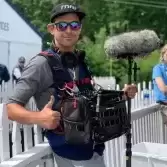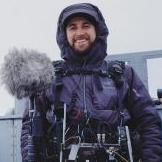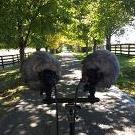-
Posts
1,810 -
Joined
-
Last visited
Profile Information
-
Location
.
-
About
.
-
Interested in Sound for Picture
Yes
Recent Profile Visitors
12,971 profile views
-

Best options for minimizing clothing rustles on lav mics?
Ze Frias replied to Thomas Farmer's topic in Equipment
This. -
They are the 800x versions, which I think were the lowest speed they would do at that capacity at the time.
-
Interesting. Both of my Transcend 128GBs are working fine in my Nova. I probably will upgrade to Sandisk 256GBs eventuall just to have more space in my "internal drive".
-

A review of Nova “OneUnit” and mrx214 wireless modules.
Ze Frias replied to RadoStefanov's topic in Equipment
The mic pres on the Nova are the best and quietest that Zaxcom has ever released. 140dB of dynamic range. Clean and transparent sounding. It's the bee's knees. -

A review of Nova “OneUnit” and mrx214 wireless modules.
Ze Frias replied to RadoStefanov's topic in Equipment
There's at least a few dozens out in the wild, and they keep delivering more every week. -
Aside from the RF loop outs on the side, the production model will look pretty much identical to the unit you see on the photos. IMO not much of an issue. If you are using a whip antenna, your fingers can wrap around the headphone knob in such a way to not conflict with the antenna position. Basically, you'll get used to it. On the other hand, you could use a different type of antenna. For example, I will be using dipoles instead of whips with my Nova, and remote the antennas to the front of the bag using short cables with right angled connectors (as I currently do with my Nomad / RX-12 bag).
-
We're obviously getting into semantics here, but at that point I think that calling it 0dBFS / full scale is not appropriate, but I see your point.
-
This is correct, but we are talking about the 32-bit floating point in a >>recording<< application when it comes to the F6. Your original comment I quoted made it seem that you can still >>record<< above 0dBFS: "32bit float on the other hand allows the signal to go above 0dBFS and can still capture it just fine". Unless Zoom is doing some magic I'm unaware of here, their double ADCs are still bound to a fixed point / integer math, and unless they calibrate 0dBFS to not represent the full scale of their ADCs, then 0dBFS does in fact represent the the maximum signal you can >>record<< before clipping.
-
It was great seeing you Brenda!
-
I edit primarily in Premier Pro, and it does support 32-bit floating point. I believe it's the only NLE that does. I do not think / know if Avid Media Composer or Final Cut Pro X support anything higher than 24-bits integer. If they do not support the higher bit depth (or sampling rate for that matter), the NLE would conform the file to the sequence settings (usually 48k / 24-bits), which would be fine. With proper gain staging, a 32-bit float file would look and sound just fine in any sequence. The issue would mostly be if the NLE conforms a 32-bit float file that's been gain staged too low. Post sound would have to replace all the sound from the EDLs with the original production sound files to be able to take advantage of the 32-bit float and add as much gain as needed. 0dBFS represents the maximum signal level in the digital domain, regardless of how many bits the file is recorded with.
-
Unlike the Nomad, there's no "input configuration" to be done in the Nova. All the inputs (whether it be RX, AES or analog inputs) will be always available for assignment to mixing buses and card tracks. You can use any and all combinations of inputs at the same time. Your example of 2x QRX212 plus 2x QRX200 would definitely be possible and is very much the intended function of providing additional AES inputs and RF loop outs on the Nova.
-
Happy birthday Jeff! As always, it was great to see you last week at NAB.
-
Regarding the 32-bit vs 24-bit (as well as recording in higher sampling rates), I always like to quote the following article: https://people.xiph.org/~xiphmont/demo/neil-young.html Specifically, the paragraph below: While I think the idea of 32-bit float recording is nice in theory, I also don't think it's a necessary feature for production sound recording. In fact, it may create more confusion and issues in post, particularly when the AE ingests our files and syncs them, and they see that dialog ins't gain staged as normal (or at least it wouldn't look good if I'm having to explain why gain staging properly didn't matter since they're 32-bit float files to the producer and/or editor who are calling me inquiring about them). 24-bit provides enough dynamic range to capture the entire usable dynamic range of any microphone (from above its self-noise to its Max SPL). IMO the only place where higher dynamic range (and higher sampling rates) is really useful, is in post, for DSP. I'm sure for consumers and prosumers alike, the idea that they can record in 32-bit float files and not have to worry about properly gain staging during recording (the whole "fix it in post" mentality) may sound like a great thing. For the rest of us (or at least for me), I think while cool, not really needed.








